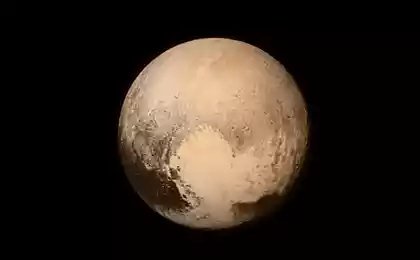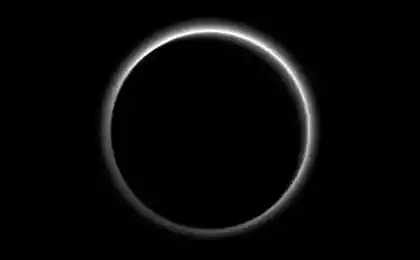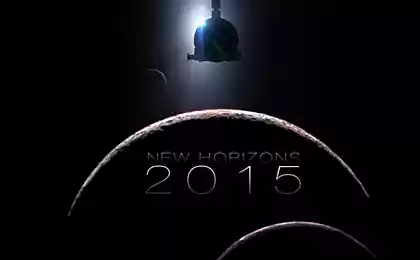1066
New Horizons team showed the first images of Pluto and its satellites with a resolution of up to 400 meters per pixel
Today at 22:00 Moscow time a press conference NASA, which New Horizons team showed the first images of the Pluto system, which unit did on July 14 during the closest approach to the dwarf planet.
... And they are beautiful.

The entire text of the article is based on notes taken during the just-ended conference. All images were shown during the briefing and are now available on the website NASA . Basically, the article used photos from the site, but below are some images - screenshots from the video stream. In any case, it is worth noting that these images are not original quality - New Horizons sent to Earth compressed pictures; the original data is to be expected in the next few months. In a previous article plan data illuminated a little more detail.
The first picture Hydra , one of the four small moons of Pluto

Image Source: NASA-JHUAPL-SwRI i>
This picture was taken from a distance of about 650,000 km from the satellite, the resolution is about 3 kilometers per pixel. Dimensions Hydra is now estimated at 43x33 km. On the surface reflectivity of the satellite made the first assumption, that its surface is mostly made of water ice.

Screenshot from the video stream i>
It depicts an attempt to approximate the New Horizons team Hydra relief on the basis of the image above.
Map of methane on Pluto

Image Source: NASA-JHUAPL-SwRI i>
The first images from low-resolution spectroscope Ralph, starred in the infrared range, superimposed on a (relatively) old pictures Pluto LORRI / MVIC (cameras, taking pictures in visible light). These pictures were taken July 13 and sent to Earth shortly before the closest flight through the New Horizons Pluto.
The picture of Charon almost the same resolution , in which Pluto was taken at yesterday's photo

Image Source: NASA-JHUAPL-SwRI i>
According to first estimates, the canyon in the upper right portion of the image has a depth of 6 to 10 kilometers. The dark area on the north pole of Charon, likely to be a "touch" of the material, as it may indicate that the areas like impact craters, the sample surface, painted in a lighter color.
This black and white picture with the camera LORRI was painted using the color data with staff on July 13, with a color camera MVIC.
The first photograph of the surface of Pluto, high resolution (from a distance of 77,000 km)

Image Source: NASA-JHUAPL-SwRI i>
This photograph shows a section of the surface, was on the southern edge of the disk of Pluto to all previous full-frame images of the dwarf planet (just south of the equator). Apparently, this area - a relatively "young" (in the conference sounded cautious assessment of "at least 100 million years old"), as evidenced by the lack of impact craters. The mountains in the image is estimated at 3.5 kilometers. Team New Horizons can not yet give a clear answer to the question of the nature of the terrain. Presumably, these mountains are composed mainly of water ice.
A little bit of additional facts

Screenshot from the video stream i>
According to first estimates, Pluto does not look like close to Neptune's moon Triton, as previously assumed. In general, the surface of Pluto is estimated to be extremely diverse, "any other similar body in the Solar System have not seen».
There is evidence that Pluto's atmosphere is currently "leaking" into space is much more active than expected. Alan Stern believes that Pluto has kriovulkany and geysers (and as a consequence, complex internal processes), although visually their existence has not been confirmed in any of the men at the moment shots.
Charon apparently geologically active. Atmosphere on it has not yet been found.
The team called the New Horizons offers bright "heart" near the equator of Pluto Tombo region , the name of the discoverer of this celestial body Clyde Tombaugh. This is not an official name of the neighborhood.
Source: geektimes.ru/post/253602/
... And they are beautiful.

The entire text of the article is based on notes taken during the just-ended conference. All images were shown during the briefing and are now available on the website NASA . Basically, the article used photos from the site, but below are some images - screenshots from the video stream. In any case, it is worth noting that these images are not original quality - New Horizons sent to Earth compressed pictures; the original data is to be expected in the next few months. In a previous article plan data illuminated a little more detail.
The first picture Hydra , one of the four small moons of Pluto

Image Source: NASA-JHUAPL-SwRI i>
This picture was taken from a distance of about 650,000 km from the satellite, the resolution is about 3 kilometers per pixel. Dimensions Hydra is now estimated at 43x33 km. On the surface reflectivity of the satellite made the first assumption, that its surface is mostly made of water ice.

Screenshot from the video stream i>
It depicts an attempt to approximate the New Horizons team Hydra relief on the basis of the image above.
Map of methane on Pluto

Image Source: NASA-JHUAPL-SwRI i>
The first images from low-resolution spectroscope Ralph, starred in the infrared range, superimposed on a (relatively) old pictures Pluto LORRI / MVIC (cameras, taking pictures in visible light). These pictures were taken July 13 and sent to Earth shortly before the closest flight through the New Horizons Pluto.
The picture of Charon almost the same resolution , in which Pluto was taken at yesterday's photo

Image Source: NASA-JHUAPL-SwRI i>
According to first estimates, the canyon in the upper right portion of the image has a depth of 6 to 10 kilometers. The dark area on the north pole of Charon, likely to be a "touch" of the material, as it may indicate that the areas like impact craters, the sample surface, painted in a lighter color.
This black and white picture with the camera LORRI was painted using the color data with staff on July 13, with a color camera MVIC.
The first photograph of the surface of Pluto, high resolution (from a distance of 77,000 km)

Image Source: NASA-JHUAPL-SwRI i>
This photograph shows a section of the surface, was on the southern edge of the disk of Pluto to all previous full-frame images of the dwarf planet (just south of the equator). Apparently, this area - a relatively "young" (in the conference sounded cautious assessment of "at least 100 million years old"), as evidenced by the lack of impact craters. The mountains in the image is estimated at 3.5 kilometers. Team New Horizons can not yet give a clear answer to the question of the nature of the terrain. Presumably, these mountains are composed mainly of water ice.
A little bit of additional facts

Screenshot from the video stream i>
According to first estimates, Pluto does not look like close to Neptune's moon Triton, as previously assumed. In general, the surface of Pluto is estimated to be extremely diverse, "any other similar body in the Solar System have not seen».
There is evidence that Pluto's atmosphere is currently "leaking" into space is much more active than expected. Alan Stern believes that Pluto has kriovulkany and geysers (and as a consequence, complex internal processes), although visually their existence has not been confirmed in any of the men at the moment shots.
Charon apparently geologically active. Atmosphere on it has not yet been found.
The team called the New Horizons offers bright "heart" near the equator of Pluto Tombo region , the name of the discoverer of this celestial body Clyde Tombaugh. This is not an official name of the neighborhood.
Source: geektimes.ru/post/253602/























